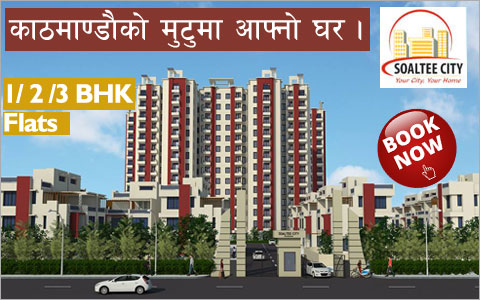National News

Banks and financial institutions (BFIs) are still shy of lending to developers of realty projects, but they have been readily issuing loans to home buyers. Over the last one year, the issuance of home loans of up to Rs 10 million has increased by Rs 19 billion.
According to Nepal Rastra Bank (NRB), home loans surged to Rs 77 billion in February 2014 from Rs 58 billion in February 2013. On the other hand, real estate loans have continued to decline. Realty loans came down by Rs 7 billion to Rs 82.8 billion during the review period.
The government has classed home loans of up to Rs 10 million as being outside the real estate category, which also contributed to the rise in home loans and a decline in realty loans. Lending by all commercial, development banks and finance companies to home buyers has risen.
Meanwhile, loan exposure to real estate was recorded at 7.8 percent as of February 2014, which is well below the 10 percent maximum limit set by the central bank. Development banks have 8.36 percent loan exposure to real estate.
"Exposure to real estate has decreased significantly, and the current level of exposure won't affect the financial system badly," said Hari Prasad Kafle, executive director of NRB. Development banks and finance companies which had relatively higher exposure to real estate have reduced their lending to the sector. Bankers said that home loans were one of the less risky sectors to invest in as they are issued to people who want to own homes, and have a regular income source and cash flow.
In order to attract people towards home loans, banks have reduced the interest rate up to 8 percent. Excess liquidity with banks has also helped to reduce the interest rate and increase investment in the sector.
"Interest rates on home loans are one of the lowest in the market," said Sashin Joshi, chief executive officer of NIC Bank Asia. According to him, those wishing to purchase land to build a house are getting loans amounting up to 50 percent of the value of the collateral. "Likewise, for those purchasing land and houses, loans have gone up to 70 percent of the value of the collateral," he said.
However, BFIs are hardly lending to developers. After a few housing projects went into a tailspin, BFIs have been reluctant to put money in housing and apartment projects.
"We have not made any fresh loan commitments to any new housing project," said Ratna Raj Bajracharya, chief executive officer of Global IME Bank. "In fact, no new project has come forward with a loan proposal."
He added that his bank had been lending money to projects to which it has pledged financing, and the loan recovery from these projects has been satisfactory. The interest rate for such projects is 12-12.5 percent currently, down from 14 percent earlier.
According to the Nepal Land and Housing Developers' Association (NLHDA), out of the 9,000 apartment built after 2005, around 5,500 have been sold. Developers said that sales of apartments had swelled lately due to increased lending by banks to buyers.
Apart from apartment sales, the trend of renting out flats after buying them has also risen. Facilities like electricity, regular drinking water supply and security have attracted people towards apartments.
This trend has helped housing projects regain momentum. "As most of the buyers live in foreign countries, they tend to rent out their property," said developers.
Prices of apartments have remained largely stable over the last two years despite rising inflation. "That's one reason why buyers have been increasingly attracted to purchasing apartments now," said Joshi. According to him, lending to buyers to purchase completed apartments has increased. However, banks are not giving loans to developers as many units are yet to be sold.
Bankers said that the issuance of loans to developers could also increase in the days to come provided projects were developed as per the need of the middle class. They said that banks would find it hard to lend to projects that are expensive and which people cannot afford as investing in them would be risky.
In the past, developers constructed apartment units costing more than Rs 10 million which bankers said were not affordable to many. "There is a chance of increasing loans to developers too provided they shift their focus to building affordable housing," said Bajracharya.
Two years ago, when apartments were lying unsold, NRB had urged developers to slash prices and sell them off to avoid accumulating outstanding principal and interest payments waiting for wealthy customers.
Developers have admitted that mid- and low-range apartments and homes have been selling well. Houses and apartments with price tags of between Rs 5 million to Rs 10 million are in high demand in the Kathmandu valley, revealed a 2013 study carried out by Brihat Investment, a research company. About 82 percent of the houses and 72 percent of the apartments sold were in the price range of Rs 5-10 million.
source:the kathmandu post,8 may 2014
- 9th Nepal Buildcon International Expo 2024
- Real Estate Expo 2023
- NRB raises housing loan limit to encourage home constructions
- Nepal Rastra Bank (NRB) Monetary Policy 2080-2081
- New Price of Land in Kathmandu Metropolitan City, Nepal
- Capital Gains Tax Rate on Real Estate Transactions in Nepal 2080-81 ( 2023/24 )
- Kathmandu metropolis implements free parking policy for commercial buildings and hospitals

![[X]](https://www.housingnepal.com/images/popup-close-button.png)












































































































































































































































































































































































































































































































 Facebook
Facebook
 Delicious
Delicious
 Digg
Digg
 Reddit
Reddit
 Stumble Upon
Stumble Upon









